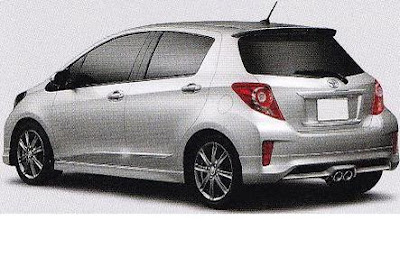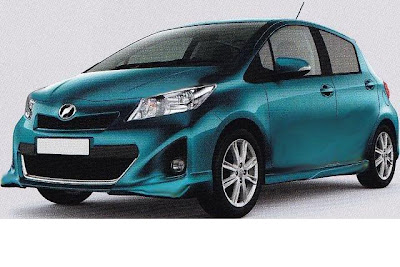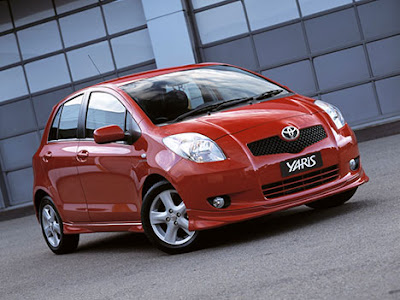Toyota 2012 Yaris
Overview
Since the primary-generation Yaris went on sale in Australia in 19ninenine (badged because the Echo), Toyota’s compact car has consistently been a best-seller here - dookin' it out with the Mazda2 and also the discontinued Getz for top spot in the light automotive phase.
Now in its third generation, the Yaris has been comprehensively updated.
The all-new Kia Rio, Hyundai Accent, Nissan Micra, Suzuki Swift and even the VW Polo are key competitors to the Yaris, and every one have important showroom appeal.
It's the Mazda2 but that, despite its age, continues to dominate the sunshine automotive segment.
After spending daily at the wheel of the 2012 Yaris, we have a tendency to’ve little doubt that this car is going to reignite Toyota’s fortunes and take the battle to the evergreen Mazda2.
Quality, style and space have all been improved, which crucial lightweight-automotive quality - worth for money - has been significantly boosted within the new Yaris vary.
Interior
The cabin of the previous Yaris was a polarising environment.
Some loved the quirkiness of its centrally-mounted instrument cluster and appreciated the numerous cubby holes designed into the dashboard.
Others hated the low-rent appearance of the grey cabin plastics and its overwhelmingly spartan styling.
Things have modified for 2012. Radically.
That central-mounted digital speedometer is gone, and the instrument cluster - repositioned right in front of the driver - employs giant, clearly-marked analogue dials.
The heating and ventilation controls are relocated higher up the dashboard to enhance visibility and convey them nearer to the driving force’s reach, and also the dash and door plastics now feature an engaging, heavily-grained texture.
The front seat frames are redesigned to allow more higher body support, and a 50mm stretch in wheelbase will increase rear occupant knee room by 35mm.
The new Yaris’ roof height has been dropped some 20mm, but it's compromised neither front nor rear headroom.
A 100mm increase in overall length additionally gives the new Yaris a 20mm longer boot area, expanding cargo capacity to 286 litres.
Dimensionally, the new Yaris is a abundant a lot of accommodating vehicle than its predecessor. Our only grievance is that the bottom YR misses out on a telescoping steering column, and that the steering columns on the YRS, YRX and ZR don’t telescope out way enough.
On The Road
We drove the high-grade YRX, sporty ZR and entry-level YR 3-door manual (during a fetching shade of pink, no less) at the launch. Each impressed bar a few niggling complaints.
The YRX’s robust standard equipment list created it stand out the instant we tend to sat in it. It felt quite unusual to be sitting in a light hatchback observing a fully-integrated touchscreen sat-nav system.
Another factor we tend to immediately appreciated was the repositioned instrument cluster. Visibility of each instrument is now a lot of higher, and the big speedometer is straightforward to read at a look.
Forward visibility isn’t quite so smart at shallow intersections but, thanks to the raked A-pillars.
On the road the YRX’s 80kW one.5 litre engine spins freely and easily, and produces plenty of power for the daily grind. It’s noisy when worked arduous though, that was somewhat shocking given the extra sound deadening that’s been applied to the new Yaris.
We are a little surprised that Toyota has persisted with the four-speed automatic. It's a bit behind the days when most competitors are moving to six-speed autos, twin-clutch autos or CVTs.
A a lot of economical CVT is obtainable on foreign market versions of the Yaris, but per Toyota Project Manager Takao Matsuki, Australian drivers tend to prefer conventional autos than the “rubber-band feeling” of a CVT.
Still, that long-lived four-speed automatic works fine in the Yaris, although its kick-down performance could use some sharpening up. And, having an additional gear would certainly help within the hills.
Next up was the ZR. Its sportiness is limited to its styling; it shares its engine, drivetrain and suspension with the YRS 3-door manual. That said, it’s still smart fun to punt along a mountain road.
The electrical power steering system was calibrated specifically for the Australian market, and options a faster rack-rate than the recent model.
The steering feels direct and therefore the Yaris exhibits terribly keen turn-in response. Its Macpherson strut and torsion beam suspension layout mirrors that of most alternative light hatchbacks currently on sale, but the Yaris’ roadholding is among the most effective.
Power delivery in the one.5 litre manual ZR suffered from a definite torque ‘hole’ within the midrange. You've ought to rev the engine hard if you're trying for a quick turn of speed.
fortunately, the 1.5 litre 1NZ-FE four-pot likes to rev.
Clutch feel may be improved in addition. The clutch pedal within the manual-equipped Yaris felt very spongy and had a imprecise friction point - one thing you don’t get in a Swift or Mazda2.
Lastly, the Yaris YR showed that its smaller 63kW/121Nm one.3 litre 2NZ-FE engine isn’t a lot of of a handicap on regular roads, with its power deficiency only becoming a true issue at (or whereas in a very hurry to succeed in) highway speeds.
Handling for the YR felt nearly indistinguishable from the ZR or YRX - all Yaris variants after all share the identical suspension hardware.
Since the primary-generation Yaris went on sale in Australia in 19ninenine (badged because the Echo), Toyota’s compact car has consistently been a best-seller here - dookin' it out with the Mazda2 and also the discontinued Getz for top spot in the light automotive phase.
Now in its third generation, the Yaris has been comprehensively updated.
The all-new Kia Rio, Hyundai Accent, Nissan Micra, Suzuki Swift and even the VW Polo are key competitors to the Yaris, and every one have important showroom appeal.
It's the Mazda2 but that, despite its age, continues to dominate the sunshine automotive segment.
After spending daily at the wheel of the 2012 Yaris, we have a tendency to’ve little doubt that this car is going to reignite Toyota’s fortunes and take the battle to the evergreen Mazda2.
Quality, style and space have all been improved, which crucial lightweight-automotive quality - worth for money - has been significantly boosted within the new Yaris vary.
Interior
The cabin of the previous Yaris was a polarising environment.
Some loved the quirkiness of its centrally-mounted instrument cluster and appreciated the numerous cubby holes designed into the dashboard.
Others hated the low-rent appearance of the grey cabin plastics and its overwhelmingly spartan styling.
Things have modified for 2012. Radically.
That central-mounted digital speedometer is gone, and the instrument cluster - repositioned right in front of the driver - employs giant, clearly-marked analogue dials.
The heating and ventilation controls are relocated higher up the dashboard to enhance visibility and convey them nearer to the driving force’s reach, and also the dash and door plastics now feature an engaging, heavily-grained texture.
The front seat frames are redesigned to allow more higher body support, and a 50mm stretch in wheelbase will increase rear occupant knee room by 35mm.
The new Yaris’ roof height has been dropped some 20mm, but it's compromised neither front nor rear headroom.
A 100mm increase in overall length additionally gives the new Yaris a 20mm longer boot area, expanding cargo capacity to 286 litres.
Dimensionally, the new Yaris is a abundant a lot of accommodating vehicle than its predecessor. Our only grievance is that the bottom YR misses out on a telescoping steering column, and that the steering columns on the YRS, YRX and ZR don’t telescope out way enough.
On The Road
We drove the high-grade YRX, sporty ZR and entry-level YR 3-door manual (during a fetching shade of pink, no less) at the launch. Each impressed bar a few niggling complaints.
The YRX’s robust standard equipment list created it stand out the instant we tend to sat in it. It felt quite unusual to be sitting in a light hatchback observing a fully-integrated touchscreen sat-nav system.
Another factor we tend to immediately appreciated was the repositioned instrument cluster. Visibility of each instrument is now a lot of higher, and the big speedometer is straightforward to read at a look.
Forward visibility isn’t quite so smart at shallow intersections but, thanks to the raked A-pillars.
On the road the YRX’s 80kW one.5 litre engine spins freely and easily, and produces plenty of power for the daily grind. It’s noisy when worked arduous though, that was somewhat shocking given the extra sound deadening that’s been applied to the new Yaris.
We are a little surprised that Toyota has persisted with the four-speed automatic. It's a bit behind the days when most competitors are moving to six-speed autos, twin-clutch autos or CVTs.
A a lot of economical CVT is obtainable on foreign market versions of the Yaris, but per Toyota Project Manager Takao Matsuki, Australian drivers tend to prefer conventional autos than the “rubber-band feeling” of a CVT.
Still, that long-lived four-speed automatic works fine in the Yaris, although its kick-down performance could use some sharpening up. And, having an additional gear would certainly help within the hills.
Next up was the ZR. Its sportiness is limited to its styling; it shares its engine, drivetrain and suspension with the YRS 3-door manual. That said, it’s still smart fun to punt along a mountain road.
The electrical power steering system was calibrated specifically for the Australian market, and options a faster rack-rate than the recent model.
The steering feels direct and therefore the Yaris exhibits terribly keen turn-in response. Its Macpherson strut and torsion beam suspension layout mirrors that of most alternative light hatchbacks currently on sale, but the Yaris’ roadholding is among the most effective.
Power delivery in the one.5 litre manual ZR suffered from a definite torque ‘hole’ within the midrange. You've ought to rev the engine hard if you're trying for a quick turn of speed.
fortunately, the 1.5 litre 1NZ-FE four-pot likes to rev.
Clutch feel may be improved in addition. The clutch pedal within the manual-equipped Yaris felt very spongy and had a imprecise friction point - one thing you don’t get in a Swift or Mazda2.
Lastly, the Yaris YR showed that its smaller 63kW/121Nm one.3 litre 2NZ-FE engine isn’t a lot of of a handicap on regular roads, with its power deficiency only becoming a true issue at (or whereas in a very hurry to succeed in) highway speeds.
Handling for the YR felt nearly indistinguishable from the ZR or YRX - all Yaris variants after all share the identical suspension hardware.
Toyota 2012 Yaris
Toyota 2012 Yaris
Toyota 2012 Yaris
Toyota 2012 Yaris
Toyota 2012 Yaris
Toyota 2012 Yaris





No comments:
Post a Comment